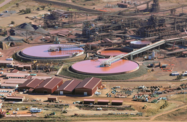With electricity demand still straining supply, South Africa’s state-owned utility, Eskom, is looking to invest in new generation facilities, rationalise consumption and diversify its energy mix.
In mid-November, Eskom called on its main heavy industry clients to reduce their power consumption by 10% during peak periods to avoid widespread outages. While these restrictions lasted a few days rather than the up to two weeks originally anticipated, manufacturers incurred losses and the cuts did little to boost confidence in future power supplies.
The near-miss was a reminder of the rolling blackouts suffered by the country throughout 2008 and underlined the urgency of the growing energy deficit. As the Department of Energy (DoE) has conceded, investment in the energy sector over the past 20 years has not been enough to meet the rapid demand growth that began in the early 2000s. The fact that there have not been more blackouts since 2008 is largely the result of a global economic slowdown, which has reduced domestic industrial activity.
Although capacity expansion has not kept pace with demand, two new coal-fired power plants – Medupi and Kusile – are nearing completion. Each will add 4800 MW to the grid, making them among the largest power stations in the world. Medupi is expected to be ready in late 2014, followed by Kusile soon after.
Reducing demand
Alongside the planned long-term expansion in capacity, Eskom has sought to slow demand growth, calling upon both retail and corporate customers to reduce their consumption, especially during peak demand hours.
The government has also announced plans to provide tax incentives to companies that initiate measures to reduce consumption.
According to Nelisiwe Magubane, director-general of the DoE, the aim of the programme is not just to have companies cut consumption through reducing activity but to promote energy efficiency.
“The allowance for energy efficiency savings will provide tax incentives for energy savings improvements, as outlined in regulations for businesses based on measured and verified energy savings through registrations with the South African National Energy Development Institute,” said Magubane.
The incentives, which are expected to be published shortly and come into force early in the new year, set out a tax write-off of R0.45 ($0.04) for every KWh of energy saved. Not only will the incentives result in lower consumption and less wastage, but they should also contribute to a reduction in greenhouse gas emissions, Magubane said.
Diversifying energy sources
With up to 95% of South Africa’s electricity generated through coal-fired power stations, and the country being ranked among the top 25 greenhouse gas producers globally, any such reduction would be a small but positive step in reducing pollution. The government also plans to introduce a carbon tax in 2015, which would levy a fee of R120 ($11.64) per tonne of carbon dioxide emitted, although the measure has been subject to intense debate, with industry expressing concerns over the high rate, which could increase costs and lead to job losses.
While coal is expected to remain the primary source of fuel for power plants, the country is moving toward a more diversified energy mix, according to Steve Lennon, a sustainability group executive at Eskom, including more renewables. Speaking at an annual conference sponsored by the South African Chamber of Commerce and Industry in October, Lennon said alternatives included shale gas, solar and nuclear.
Long-term strategic plans from the DoE similarly highlight these and other sources of energy, although the latest announcements from the department indicate a shift away from nuclear and towards gas, with cost the primary motivating factor.
In early December the DoE released a proposed update to its Integrated Resource Plan (IPR), a roadmap for power plant new build over the next two decades. According to the base case outlined by the proposal, nuclear would account for 6,660 MW of capacity by 2030, down from 11,400 in the prior iteration of the IRP, and solar and wind combined would amount to 17,430 MW. While the allocation to nuclear has declined, natural gas’s contribution has increased, moving up from 9,700 MW to 11,230 MW.
The DOE has also shifted back on its total capacity estimate for 2030, moving from 89,532 MW to 81,350 MW. This is in line with a reduction in peak demand estimates, from 67,800 MW to 61,200 MW.
While South Africa looks set to meet rising demand down the line, for now it must contend with a supply gap, although efforts to reduce consumption could help bridge any shortfall.
Follow Oxford Business Group on Facebook, Google+ and Twitter for all the latest Economic News Updates. Or register to receive updates via email.

